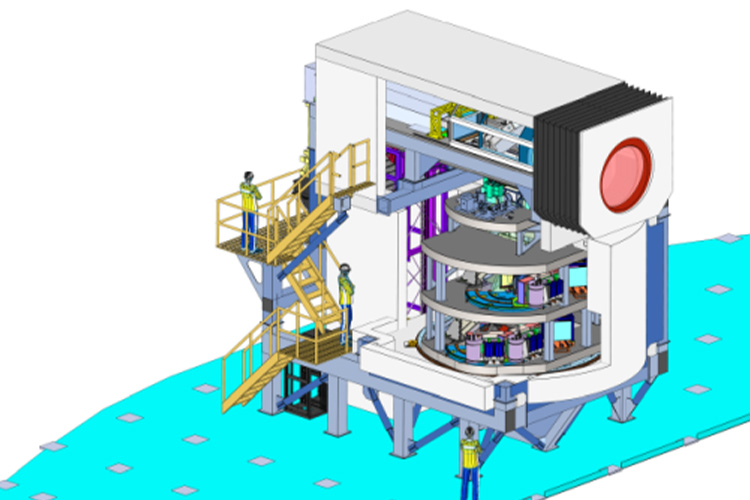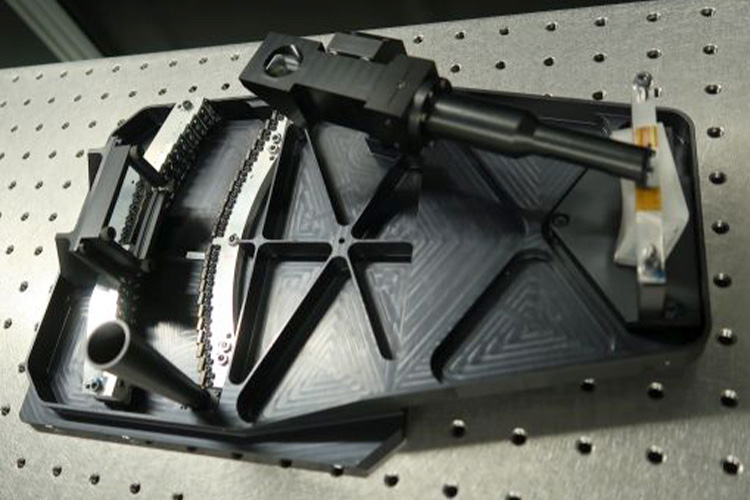Optical and Infrared Observations
Opt/ IR mission instrumentation team
Optical and infrared astronomy is one of the major fields for exploring the Universe. ATC has been playing an important role in developing astronomical instruments for the Subaru Telescope, located at the summit of Maunakea in Hawaii, as well as for the Thirty Meter Telescope (TMT), which is a state-of-the-art telescope that is under construction.
IRIS / TMT

The InfraRed Imaging Spectrograph (IRIS) is one of the first light instruments for the Thirty Meter Telescope. IRIS is being developed through international collaboration between the United States, Canada, China, and Japan. ATC, representing the Japanese contributions to the instrument, is responsible for delivering an infrared camera for IRIS. We are addressing unprecedented technical challenges unique to IRIS, including diffraction-limited optics working at liquid-nitrogen temperatures (~ -200 degC), cryogenic driving mechanisms that need to be maintenance-free for 10 years, and precision astrometry at the 10 micro-arcsec level (in other words, measuring the position of stars on the sky to within 1/100 millionth of 1 deg).
WFOS/TMT

The Wide-Field Optical Spectrometer (WFOS) has imaging and spectroscopy capabilities, and is being developed through international collaboration between the United States, India, and China. ATC is investigating the possibility of an integral field unit (IFU) for WFOS as a planned upgrade.
HSC / Subaru Telescope

Hyper Suprime-Cam (HSC) is a wide-field digital camera, mounted on the prime focus of the Subaru Telescope. The camera system developed at ATC contains 116 CCDs with 870 million pixels in total. The CCDs are sealed in a vacuum chamber, cooled to -100°C, and operated by dedicated electronics, which were also developed at ATC. HSC demonstrates overwhelming performance for discovering new objects and phenomena in the Universe with its wide-field, high-resolution, and high-sensitivity capabilities. The instrument is also used to search for dark matter, by using the gravitational lensing effect.
IR Detector Development

In collaboration with industry, we are developing CCD and CMOS sensors and near-infrared array detectors, which are necessary for visible and infrared astronomy observations. Development of the control electronics and evaluation of each detector is done in-house, leading to flexible and rapid development of new instruments. We also provide control electronics to other organizations and support for installing detectors in instruments.
FOCAS IFU/Subaru Telescope

FOCAS has been a workhorse optical spectrograph on the Subaru Telescope since it started operation. FOCAS IFU is an add-on unit for FOCAS and provides an integral field spectroscopy function which enables us to obtain spectra at every point over the field of view. This capability is suitable for observing extended objects such as galaxies. The complex parts requiring high fabrication accuracy were manufactured in ATC. And the assembly and the optical testing were also conducted in ATC. FOCAS IFU was completed in 2018, and is available for open use.
SWIMS-IFU/TAO

SWIMS-IFU is a unit that adds an integral-field spectroscopy function to the near-infrared spectrograph SWIMS of the University of Tokyo Atacama Observatory (TAO) 6.5-m telescope. SWIMS-IFU was developed through collaboration between the Advanced Technology Center, the University of Tokyo, and RIKEN. It is incredibly complex, featuring 80 mirrors, some of which are as small as a few millimeters square, all housed in a compact space the size of a lunch box. The mirrors are all machined from an aluminum alloy using ultra-precision machining to prevent any deformation even at temperatures as low as minus 200 degrees Celsius.
NINJA/Subaru Telescope

Near-INfrared and optical Joint spectrograph with Adaptive optics (NINJA) is an optical to near-infrared (NIR) spectrograph optimized for the laser tomography adaptive optics (LTAO) system at the Subaru Telescope. It can obtain a spectrum covering 0.35 - 2.5 microns simultaneously with a spectral resolution of R=3000-4000. One of the primary science objectives of this spectrograph is wide-band spectroscopic follow-up of transient sources like GRB, supernovae, or gravitational wave sources.
